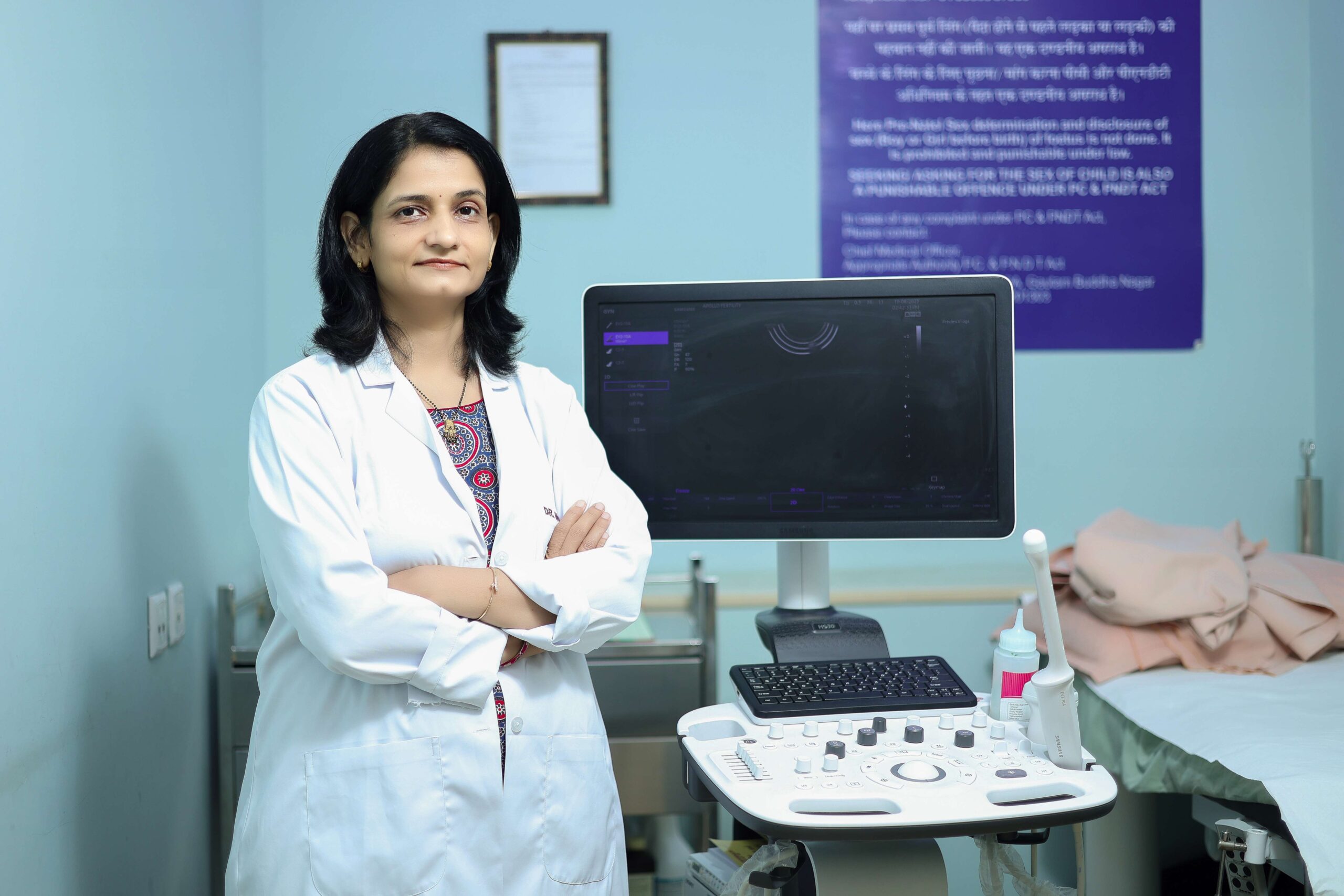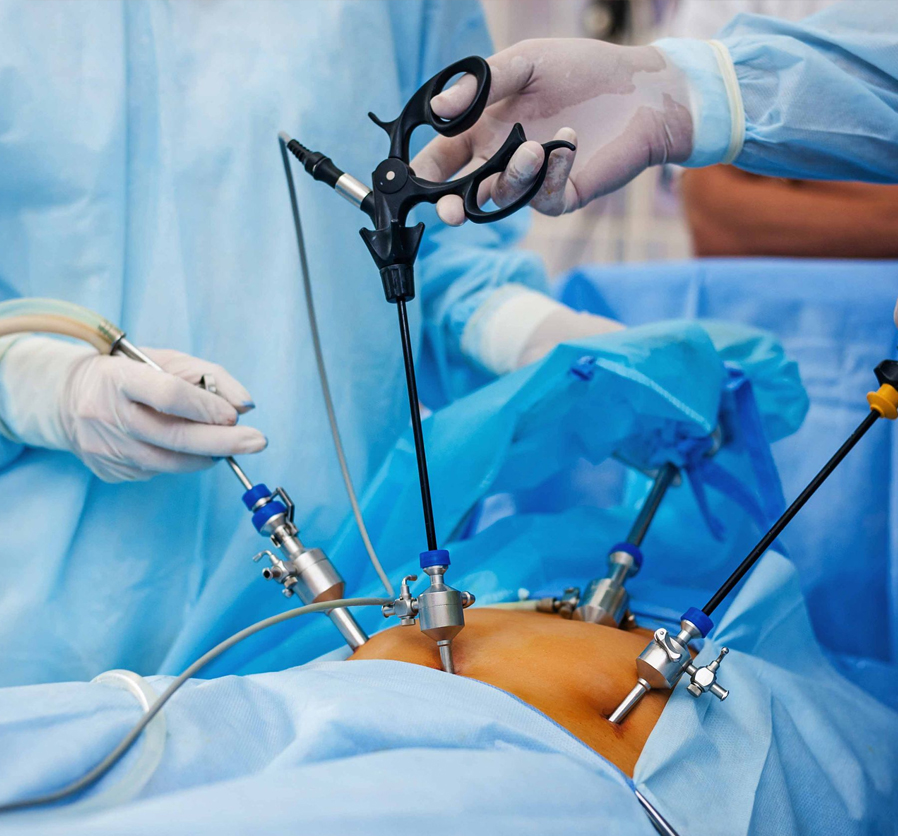Fertility Excellence for 25 Years
Laparoscopy & Hysteroscopy
5000 Happy Parents Have Trusted Dr Mona Dahiya’s 25+ years of fertility expertise in making parenthood dreams a reality.
What is Laparoscopic Surgery?
Laparoscopic surgery, also known as minimally invasive surgery or keyhole surgery, is a modern medical technique used to diagnose and treat various abdominal and pelvic conditions. This surgical approach is favored for its minimally invasive nature, which results in smaller incisions, reduced pain, shorter recovery times, and lower risk of infection compared to traditional open surgery.
Laparoscopic Surgery Procedure
- Preoperative Evaluation: Before a laparoscopic surgery, the patient undergoes a thorough preoperative evaluation to assess their overall health, medical history, and the specific condition requiring treatment. This evaluation helps determine whether laparoscopic surgery is a suitable option.
- Anesthesia: During laparoscopic surgery, the patient is placed under general anesthesia to ensure they are comfortable and pain-free throughout the procedure.
- Incision: Rather than a large, open incision, laparoscopic surgery involves making several small incisions (usually 0.5 to 1.5 centimeters in size) in the abdominal or pelvic area. These incisions are strategically placed to access the target organ or area.
- Insertion of Trocars: Trocar ports or cannulas are inserted through the incisions. These are specialized tubes that serve as entry points for the surgical instruments and the laparoscope, a thin, lighted tube with a camera on the end.
- Visualization: The laparoscope provides real-time, high-definition images of the inside of the body, allowing the surgical team to view and assess the area requiring treatment on a monitor.
- Surgical Manipulation: Tiny surgical instruments are inserted through the trocars, and the surgeon performs the necessary procedure, such as removing a gallbladder, repairing a hernia, or treating endometriosis. The surgeon watches the monitor to guide their actions.
- Closure: Once the procedure is complete, the instruments and trocars are removed, and the small incisions are closed with sutures or surgical glue. Since the incisions are minimal, scarring is usually minimal as well.

Laparoscopic Surgery Success Rate in Noida
Laparoscopic surgery has gained popularity in Noida due to its many advantages. The success rate of laparoscopic surgery in Noida varies depending on the specific procedure and the expertise of the surgical team. However, it generally boasts a high success rate.
- Gallbladder Removal (Cholecystectomy): This common laparoscopic procedure has a success rate of over 95% in Noida. Patients typically experience less pain, shorter hospital stays, and quicker recoveries compared to open surgery.
- Hernia Repair: Laparoscopic hernia repair in Noida has a success rate of approximately 90% or higher. This approach is preferred for its reduced risk of complications and faster return to regular activities.
- Hysterectomy: Laparoscopic hysterectomy, used for conditions like fibroids and endometriosis, has a success rate of around 85% to 90%. It offers less scarring, lower infection risk, and faster healing compared to traditional open hysterectomy.
- Appendectomy: Laparoscopic appendectomy has a success rate of over 90%. It is favored for its minimal incisions, shorter hospital stays, and lower post-operative infection rates.
Laparoscopic Surgery Cost in Noida
One of the significant advantages of undergoing laparoscopic surgery in Noida is its cost-effectiveness. The cost of laparoscopic surgery in Noida is significantly lower than in many Western countries, without compromising on the quality of care. Here are approximate cost ranges for some common laparoscopic procedures in Noida:
- Gallbladder Removal (Cholecystectomy): The cost of laparoscopic gallbladder removal in Noida typically ranges from ₹70,000 to ₹1,75,000.
- Hernia Repair: Laparoscopic hernia repair in Noida costs between ₹70,000 and ₹1,40,000, depending on the type and complexity of the hernia.
- Hysterectomy: The cost of laparoscopic hysterectomy in Noida varies between ₹1,40,000 and ₹2,45,000, depending on factors like the type of hysterectomy and the patient’s condition.
- Appendectomy: Laparoscopic appendectomy in Noida generally costs between ₹56,000 and ₹1,12,000.
Why Choose Us?
BEST IVF DOCTOR IN NOIDA

Treatment Options
Dr Mona Dahiya offers a diverse range of advanced infertility treatments tailored to individual needs. From IVF and IUI to fertility preservation, a comprehensive spectrum of options ensures personalized care for every patient.

Reviews of Patients
Patient testimonials from Our Satisfied Patients is a testimony of our assurance and confidence that reflects Dr Mona Dahiya’s excellence and compassionate approach. Our Satisfied patients are a testimony of our assurance and confidence.

Understanding
We prioritize deep understanding and empathy toward each patient’s emotional journey. We provide a supportive environment where concerns are heard and anxieties are eased for emotional Well-being.

Success Stories
We are proud of our success stories of Couples who have undergone infertility treatment. Our stories not only inspire hope but also exemplify our proficiency in turning dreams of parenthood into reality.

Tailor-Made Plans
Recognizing that every patient is unique, Dr. Mona Dahiya crafts personalized treatment plans. We consider medical history and individual circumstances to Guide Tailor Made Infertility Treatment Options.
Experience the Joy of Parenthood with the
Best IVF Center in Noida

Meet Our Fertility Specialist
Dr. Mona Dhaiya
Book Your Appointment
Benefits of Laparoscopic Surgery
- Minimally Invasive Approach: Laparoscopic surgery involves making small incisions, typically 0.5 to 1.5 centimeters in size, compared to the larger incisions required in traditional open surgery. This minimally invasive approach results in less tissue trauma and reduced postoperative pain.
- Faster Recovery: Patients who undergo laparoscopic surgery often experience shorter hospital stays and quicker recoveries compared to open surgery. This means they can return to their daily activities sooner.
- Reduced Scarring: Due to the smaller incisions, laparoscopic surgery typically results in minimal scarring. This cosmetic advantage is especially appealing to many patients.
- Lower Risk of Infection: Smaller incisions and less tissue exposure reduce the risk of surgical site infections, a common concern in open surgery.
- Improved Precision: Laparoscopic procedures provide surgeons with a magnified view of the surgical area through a camera (laparoscope) inserted into the body. This enhanced visualization allows for precise and accurate surgery.
- Less Blood Loss: The minimally invasive nature of laparoscopic surgery often results in less blood loss during the procedure.

Risks of Laparoscopic Surgery
While laparoscopic surgery offers numerous benefits, it is essential to be aware of the potential risks and complications:
- Infection: Although the risk of infection is lower than in open surgery, it is not entirely eliminated. Infection can occur at the incision sites or within the abdominal cavity.
- Bleeding: While laparoscopic surgery generally results in less blood loss, bleeding can still occur during the procedure. Surgeons must carefully monitor and manage any bleeding.
- Organ Injury: There is a small risk of unintentional injury to surrounding organs during laparoscopic surgery. Surgeons take precautions to minimize this risk.
- Anesthesia Complications: As with any surgery, there is a risk of adverse reactions to anesthesia, although these are relatively rare.
- Postoperative Pain: While laparoscopic surgery typically results in less pain than open surgery, some patients may still experience discomfort during the recovery period.
- Gas-Related Discomfort: Carbon dioxide gas is used to inflate the abdomen during laparoscopic surgery, which can lead to postoperative discomfort, including shoulder pain and bloating.
Why Choose Dr. Mona Dahiya for Laparoscopic Surgery in Noida?
- Expertise and Experience: Dr. Mona Dahiya is a highly skilled and experienced laparoscopic surgeon in Noida. Her extensive knowledge and years of practice make her a trusted choice for patients seeking minimally invasive surgical solutions.
- Commitment to Patient Care: Dr. Dahiya is known for her patient-centric approach. She prioritizes patient well-being and ensures that they are well-informed about their procedure, risks, and recovery.
- State-of-the-Art Facilities: Dr. Dahiya operates in modern, well-equipped facilities in Noida. These facilities are designed to meet the highest standards of safety and patient care.
- Personalized Treatment Plans: Dr. Dahiya tailors treatment plans to meet each patient’s unique needs. She takes the time to understand their medical history and concerns, ensuring that the treatment is customized for optimal outcomes.
- Strong Track Record: Dr. Mona Dahiya has a strong track record of successful laparoscopic surgeries, earning the trust and gratitude of her patients.
- Accessibility and Convenience: Located in Noida, Dr. Dahiya’s clinic is easily accessible to residents of the city and surrounding areas. This convenience makes it easier for patients to receive the care they need.

Common Queries
Frequently Asked Questions
The average cost of a laparoscopy procedure in Noida can vary depending on factors such as the type of surgery, the complexity of the case, the hospital or clinic chosen, and whether it’s performed as an outpatient or inpatient procedure. On average, it may range from INR 20,000 to INR 60,000 or more. It’s advisable to consult with healthcare providers in Noida for specific cost estimates.
Laparoscopy can be relatively expensive due to several factors. First, it involves specialized equipment and instruments, which can be costly to maintain and use. Second, the surgical team often includes skilled surgeons, nurses, and anesthesiologists, contributing to the overall cost. Additionally, the use of a sterile operating environment and post-operative care also adds to the expenses. Lastly, the type and complexity of the procedure can influence the cost, as more intricate surgeries may require longer operating times and more resources.
Laparoscopy, like any medical procedure, is not guaranteed to be 100% successful. The success of a laparoscopic surgery depends on various factors, including the surgeon’s skill, the patient’s specific condition, and any unforeseen complications. While laparoscopy is generally considered safe and effective, there can still be risks involved, and outcomes may vary. It’s crucial to discuss the expected success rate and potential risks with your healthcare provider before undergoing the procedure.
Laparoscopy is typically less painful than traditional open surgery. During a laparoscopic procedure, small incisions are made, and a camera and specialized instruments are inserted. The use of smaller incisions and minimally invasive techniques can result in less pain, reduced scarring, and a quicker recovery compared to open surgery. However, some discomfort and pain can still be expected post-surgery, but it is usually manageable with pain medication prescribed by your doctor.
The recovery time after a laparoscopy can vary depending on the specific procedure and individual factors. In general, patients can expect a shorter recovery period compared to open surgery. Many people can resume light activities within a few days to a week after laparoscopy, but it may take several weeks to fully recover, especially for more complex surgeries. Your surgeon will provide specific post-operative instructions, including restrictions on physical activities and guidance on when it’s safe to return to your normal routine. It’s essential to follow these instructions to ensure a smooth and successful recovery.

